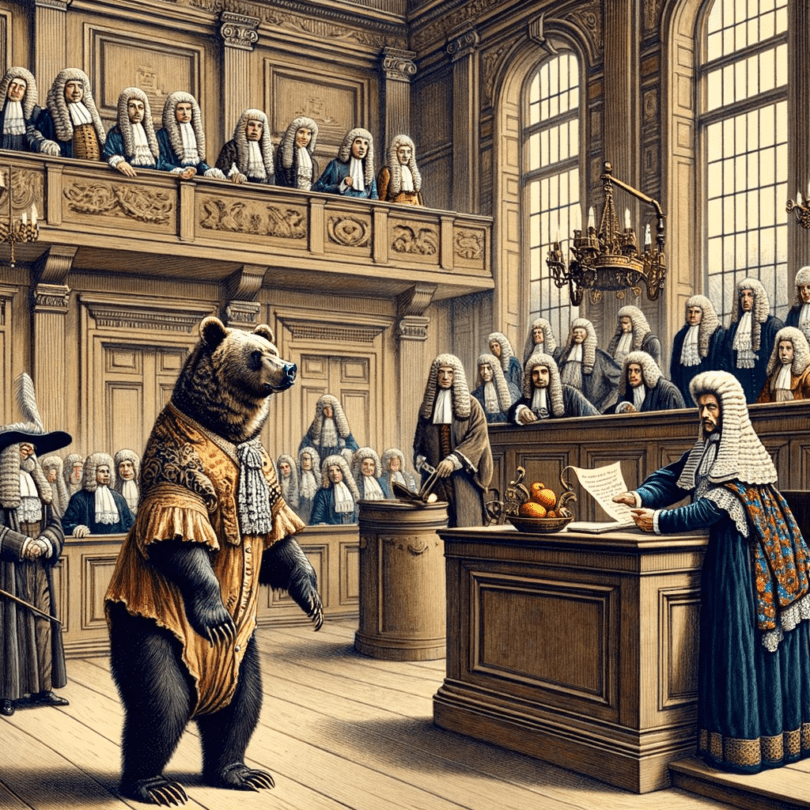A Dance of Curiosity and Compassion
Oh, animals! I’ve always been utterly fascinated by them. Their innocence, their wildness, and that odd moment where you look at them and see a bit of yourself looking back. It’s downright captivating. Now, let’s rewind to the 18th century Europe – an era that was all about bears. But not in a cute teddy bear or décor kind of way. Nope, it went much deeper and a tad darker. Bears were the stars, not just as wildlife but as entertainers and shockingly, even as courtroom defendants.
It’s like a bizarre theater of all things wild and wondrous. Picture this: amidst the lively, bustling European marketplaces and towns, where the chatter never seemed to cease and horse-drawn carriages made their merry clinks, there were bears. Not freely roving, but, sadly, dancing—not out of joy but because they were forced to. Traveling performers would journey with these captive bears, putting on shows that caught the curious gaze of many. The idea sounds whimsical until you peel back the layer to see reality—a somber truth.
Imagine bears taught to stand on their hind legs, “dancing” to music – a sight both peculiar and cruel. Captured young from the wild, they often had ropes pulled through their noses with rings painfully pierced through them. Trainers, known as bear-leaders, would tug these ropes, forcing them to obey and move in rhythm, all while the poor bears stumbled to tunes from a pipe or tambourine. Back then, cruelty was often overlooked when masked by entertainment.
If I found myself as a spectator in the 18th century, I can’t help but wonder how I would have reacted. Chuckling at the bear’s clumsy movements, perhaps, or cheering with the crowd. But there’s a part of me that hopes I’d feel an undeniable twinge of empathy. Reflection has a way of shifting perspectives over time.
Bears on Trial: An Absurd Spectacle
Now, here’s where the story takes a turn for the truly strange—bears actually put on trial. Yes, real courtrooms thought it necessary to drag a bear before a judge. Madness, right? Back in those days, the legal systems of Europe were anything but typical, mixing superstition and law in ways that make our modern laws seem terribly mundane. There were chickens once put on trial for unholy acts. Chickens! It was in this web of wild judicial antics that bears, prominent through their performances, often got entangled in legal messes.
The trials were as absurd as they come. Bears would be hauled to court for acts of aggression—or what was perceived as such. A bear scared or in pain might lash out, but back then, oh, they saw intent, malice even, attributing human like motives to these instinctual reactions. Imagine the conversations among the onlookers!
One story I stumbled upon was of a bear, Bruno, in a quaint little town which let’s just call Duremberg. The town was like many others, craving the thrill of entertainment. In a particularly crowded performance, Bruno, scared, attacked his handler. Chaos ensued. Some townsfolk empathized with Bruno, while others felt this “beast” needed to face justice, whatever that meant at the time.
Bruno’s trial was, unsurprisingly, bedlam. Picture it—a town square filled with folk, more curious than wise, shouting opinions, claiming prophecies, defending the bear’s actions. Philosophers and great thinkers even debated if animals had a moral compass or if we, the self-declared superior beings, were playing a dangerous game of master and judge. It’s bizarre, yes, but also kind of intriguing, imagining such discussions debating a bear’s moral understanding.
Echoes of History in Legal Chaos
The whole thing was both amazing and slightly amusing when seen from afar. While we don’t drag bears into court these days, the essence of that debate lingers—our sometimes puzzling relationship with animals. Have you ever wondered how we can love our pets, visit zoos, or relish a wildlife documentary knowing captivity’s shadows? I’ve thought about it often, pondering this complex dynamic.
Bruno’s tale, sadly, ended as you might expect. For being a “beast” rather than a villain, he was executed in public, a grotesque scene mingling fear and thrill, showcasing mankind’s dominion over nature—or so they thought.
Yet Bruno’s tragic ending stirred a whisper that grew—a talk of cruelty slowly stretching into the public consciousness, sowing seeds for animal rights long before they took root. Reading about these trials, I often ponder humanity’s constant attempt to make sense of chaos with limited insight. Though today it seems ridiculous, back then it was a raw endeavor to address life’s mysteries.
Bruno’s tale, as bizarre as it is enthralling, leaves a lasting lesson on human-animal relationships. While we’ve opened our eyes to the injustices of the past, our dance with understanding continues, hopefully with more empathy this time around.
So, dear reader, when you encounter tales of animals and justice, let history’s whispers guide you. Remember the dancing bears and their trials—unintentional but profound lessons hold great wisdom. It’s these stories that remind us where we’ve been and nudge us to think kindly about where we’re headed. Here’s to a future narrative rich in understanding, compassion, and the lessons we’ve learned from our complex, shared past. Honestly, that’s a hope I cling to like a fragile, beautiful thread weaving through history’s tapestry.

